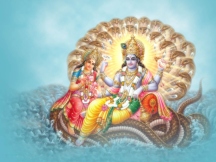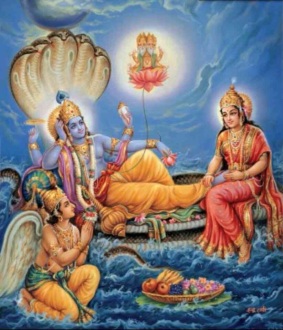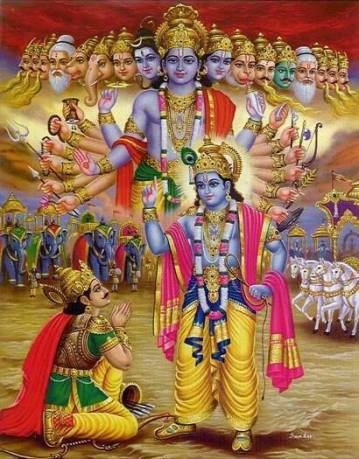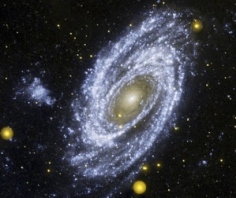
In this part we will explore the meaning of the Dhyana Shlokas 1 and 2 that we recite before chanting the Sahasranamam.
Dhyana Shloka 1
Ksheero danvat pradeshe shuchimani vilasat saikate rmouktikaanaam
Maalaa Kluptaasanasthah sphatikamaninibhair mouktikair manditaangah
ShubhraiRabhraiRadabhrai RupariVirachitair Mukta Peeyoosha Varshaihi
Aanandee Nah Puneeyaat Dari Nalina Gadaa ShankhaPaanir Mukundah
At first sight, this appears to be a complex tongue twister. But once we analyse and understand this simple and beautiful verse, we will begin to appreciate the splendour of the Lord from this Shloka. This describes the majestic view of Sri MahaVishnu in a manner that creates a vivid image that can be etched in our inner vision with ease and serves as a prelude to the Parayanam.
In any Sanskrit poem, the clue to understand the meaning lies in identifying the basic subject, predicate and the object. Rest of it is generally embellishment and descriptive clauses that adds colour to the subject, object and the predicate.
Let’s look at the meaning of the key words:
Ksheero danvat pradeshe – Sitting on the bank of the Milky Ocean
Shuchimani vilasat saikate – Shining sandy surface like diamonds
 rmouktikaanaam Maalaa Kluptaasanasthah – Adorned with pearls
rmouktikaanaam Maalaa Kluptaasanasthah – Adorned with pearls
sphatikamaninibhair mouktikair manditaangah – luminous white crystals
ShubhraiRabhraiRadabhrai – from the multitudinous white clouds
RupariVirachitair – hovering above in an arch
Mukta Peeyoosha Varshaihi – pouring torrents of nectar
Aanandee Nah Puneeyaat – Blissfully purifying
Dari Nalina Gadaa – with his hands holding Discus, Lotus and Mace
ShankhaPaanir Mukundah – Conch holding Lord Mukunda, the giver of Mukti
In this Shloka the basic nucleus is ‘Mukundah nah Puneeyaat’ meaning ‘Let Lord Mukunda purify us’. Mukunda is the name for MahaVishnu meaning ‘the giver of Mukti or Liberation’. Having identified Mukunda as the subject, we can see that all other phrases are merely adjectives describing different aspects of Mukunda.
The first description is he is ‘Aasanasthah’ or sitting on a pedestal.
Where is he seated? On which pedestal?
‘Ksheero danvat pradeshe’ – on the bank of the Milky Ocean;
‘Mouktikaanaam Maalaa Klupta’ – it is adorned with garlands of pearls;
‘Shuchimani vilasat saikate’ – on a shining sandy surface studded with pure diamonds; in other oceans the sand only contains silica crystals but on the banks of the Milky Ocean the sand is interspersed with dazzling diamonds.
Sri MahaVishnu, is seated on the diamond studded sandy banks of the milky Ocean on a seat adorning a garland of pearls.
What more can you say of Him?
He is ‘Mouktikair Mandita Angah’. His body is decorated by pearls.
‘Sphatika Mani nibhaihi’ which are luminous like white crystals.
He is Aanandee, blissful and joyous.
With what else?
Mukta Peeyoosha varshaihi – pouring torrents of nectar.
ShubhraiRabhraiRadabhaihi – From the multitudinous pure white clouds.
Upari Virachitaihi – Hovering above the shores like a decorated arch, He is enjoying the showers of nectar pouring out from the pure white clouds hovering over the shore like a specially designed canopy.
 What is he holding?
What is he holding?
Dari Nalina Gadaa Shankha Panihi – He is holding in his hand his Chakra or the Discus, Nalina or the Lotus, Gadaa or the Mace and Shankha or the Conch. These are his distinctive features!
Now combining all of the above attributes, we can form an image of HIM in our mind that is vivid and graphic.
IN SUMMARY
 “Mukunda, who is majestically seated on the banks of Milky Ocean, with the surface sand sparkling like diamonds, adorning the garland of lustrous pearls; He, who is in a joyous and ecstatic bliss with pure white clouds hovering above, raining showers of nectar. May Mukunda, who is holding the Discus (Sudharsana Chakra), Mace (Gowmodhaki Gadha), Conch (Panchajanya Sankha) and Lotus in His hands, purify and liberate us”.
“Mukunda, who is majestically seated on the banks of Milky Ocean, with the surface sand sparkling like diamonds, adorning the garland of lustrous pearls; He, who is in a joyous and ecstatic bliss with pure white clouds hovering above, raining showers of nectar. May Mukunda, who is holding the Discus (Sudharsana Chakra), Mace (Gowmodhaki Gadha), Conch (Panchajanya Sankha) and Lotus in His hands, purify and liberate us”.
This is the complete image we need to build in our mind as we recite this Dhyana Shloka.
The immediate image that flashes in our mind when we hear the term ‘Milky Ocean’ is that of the nectar churning image or that of the Lord MahaVishnu in his reclining pose as portrayed in the famous Thyagaraja composition “Ksheera Sagara Shayanaa” in Devagandhaari Ragam and Adi Taalam.
But in this Dhyana Shloka we have the image of Vishnu seated majestically on the banks of the Milky Ocean.
What is the significance of this?
When a man is actively engaged in the worldly affairs he does not devote sufficient time to think of Bhagavan and at that time Bhagavan is effectively sleeping. But when a man disengages himself from the world and embarks on worship, Bhagavan wakes up and the world (distraction) in him is put to sleep.
When we are about to focus our mind on the Absolute and away from the worldly affairs, God is activated and the world (distraction) is deactivated. That is why we find him “Aasanastha” seated and awake and ready to grant our wish for purification.
In essence with the Dhyana Shlokas we are preparing ourselves to focus our mind on the Lord and ready to awaken our ‘Chit’ or Consciousness through worship and in the process put the world (or the distraction) in us to sleep. The recitation helps to awaken ourselves and be ready to accept his grace by purifying our mind as we engage our thoughts on HIM, who will finally liberate us (moksa isyami ma sucah – BG 18.66).
Dhyana Shloka 2
Bhooh paadau yasya naabhir-viyada-suranilas-chandra-sooryau cha netre
Karnaa-vaashaas shiro-dyaur mukhamapi dahano yasya vaasteyam abdhih
Antas-stham yasya vishvam sura-nara-khaga-go-bhogi-gandharva-daityaihi
Chitram ramramyate tam tribhuvana-vapusham Vishnum Isham namaami.

In this Shloka we picturise Him in His cosmic form or Vishwaroopam. The entire Universe is contained in Him. The basic nucleus of this Shloka is ‘Vishnum Isham Namaami’ meaning ‘I worship Lord Vishnu’. The rest of the words describe how the various parts of the Universe relate to the various parts of Vishnu.
‘Bhooh Padau Yasya’ – His feet are the planet Earth
‘Naabhir Viyat’ – His navel is the Sky
‘Asuh Anilah’ – His breathing apparatus is Vayu (the Wind)
‘Chandra Suryau cha Netre’ – His eyes are the Sun and the Moon
‘Karnau Aavaashah’ – His ears are the directions
‘Shiro Dyauh’ – His head is Devalokam
‘Mukham Dahanah’ – His mouth is Fire (Agni)
‘Vaasteyam Abdhih’ – His abdomen is the Ocean
‘Antastham yasya Vishvam’ – The whole Universe resides in him.
Sura-nara-khaga-gandharva-daityaihi Chitram ramramyate – The Universe, which is the delightful playing ground of myriads of diverse life forms such as Devas, Humans, Birds, Animals, Snakes, Gandharvas and Demons.
‘Chitram ramramyate’ is a particularly beautiful construction with the threefold repetition of ‘Ram’.
And finally ‘Tribhuvana Vapusham’ meaning ‘He is the embodiment of the three worlds’.
Bringing all of these together we have the complete frame:
‘I bow to Lord Vishnu who has the three worlds as His body. The Earth is His feet, the sky His navel. Wind is His breath, the Sun and the Moon are His eyes. Directions are His ears and the Heaven is His head. Fire is His face and the Ocean His abdomen. In Him is situated the Universe with diverse kinds of Devas, men, birds, cattle, serpents, gandharvas and daityas (demons)- all enjoying a pleasurable life’
Vishwaroopam or the Cosmic form is very difficult for ordinary mortals to visualise and contemplate upon. Arjuna was granted a divine vision (divya caksu) to be able to experience the cosmic form of Krishna. And Arjuna saw:
‘Tatraikastham jagatkrtsnam Pravibhaktam Anekadhaa
Apashyat devadevasya Shareere Pandavas tadaa’
Arjuna witnessed, in the Supreme Deity, the whole Universe with its manifold divisions, condensed into one place.
Contemplation of the Dhyana Shloka 2 with full understanding gives us the same experience as Arjuna had that day.
Some of the cosmic representations in this Shloka are also described in the same way in Purusha Suktam, expounding the connection of Purusha or the Viraat Purusha with the Universe.
- ‘Praanaad Vaayur Ajaayata’ meaning Vayu or Wind came out of His breathing;
- ‘Naabhyaa raaseed Antariksham’ meaning the sky was born out of His navel;
- ‘Sheershnor Dyaus Samavartata’ meaning the Devalokam was born out of His head;
- ‘Padbhyaam Bhoomih’ meaning the Earth was born out of His feet; and
- ‘Dishas Shrotraat’ meaning the directions were born out of His ears.
Having evoked His Regal Splendour in Shloka 1 and His Cosmic Splendour in Shloka 2 in this Part, we will move on to the other Dhyana Shlokas in our subsequent Parts.
HARI OM TAT SAT
OM NAMO NARAYANAAYA
The Vishnu Sahasranamam series is authored with the help of my friend Shri Balaji.

Thank you so much.
Om Namo Narayanaya. V well explained the meaning of Dyana Slpka with beautiful pictures. God bless everyone. 🙏🏼🙏🏼
Namaskaram. A very good attempt to explain the dhyana slokas of Vishnu Sahasranama.
But there are a few corrections to be made. I am mentioning just one here.
In the first dhyana sloka, the split is given as puneeyat-dari-nalina-gada.
puneeyaadarinalinagada should be split as
puneeyaat-ari-nalina-gada
ari means discus, nalina means lotus and gada means mace.
Kindly mention the Chandas used for these Slokas and if possible Pada beds too. Explain the meter.
Beautiful understanding and explanation !
Please accept my Pranams🙏
What a marvelous depiction…!
💐💐💐
Your efforts to expound on these ambrosial verses, that too, in such lucid language, are highly commendable. Thank you very much for the explanation and insight. Hare Krishna.
Chitram ramramyate tam tribhuvana-vapusham Vishnum Isham namaami.🙏
Beautifully in details explanation..Thank you very much…God bless you .
Beautifully in details explanation..Thank you very much…God bless you .
Sridhar garu and Balaji garu, you both have done an extra ordinary job in compiling this blog. I have searched many sites for the meaning of Vishnu Sahasranamam but your blog stands out. I can imagine how much of effort it must have taken for this. I am reading few pages everyday and feel ecstatic. You both are so blessed.
Thank you so much. Sridevi🙏
Thank you 🙏 God bless you.
Justice not done fully in explaining the verses
Hari Om. Anusha, which part of the Shloka you think needs to be elaborated further? Please clarify. Thank you 🙏
dear sir,
i was searching for these meanings a long time. I am grateful to u for giving the meanings and also clarifying it so well. Hari Om
Thank you. Hari Om Tat Sat.
Great. I bow my head before u.
Hari Om! Thank you for your kind words. God bless you!
Dear Sir, For long, I have been searching the correct meanings of Dhyana slokams so that I can visualise the Bhagavat Swarupam while chanting Dhyana slokams. I cannot thank you enough for fulfilling my wish. I am so grateful.
G.Muniraju
You are welcome. Thank you _/_
Hari Om Tat Sat!
Just came across your site. Thank you for putting the subject, predicate and object in this format for it allows me to appreciate the poetic magic of this Vedantic Gem.
Thank you!
Hari Om Tat Sat!
These 2 dhyana slokas are time taking because i can’t take my mind off from them. Amazing work by Sridhar and Balaji garu. Thank you very much.
Dear Sridhar
Enjoyed reading the introduction.
I was expecting the explanation to start from
Sukhlambaradaram.
Could you post word by word meaning please for the initial slokas?
I loved the explanations. It would be helpful if the reference slokas are in Sanskrit script so that we get the pronunciation right.
Thank you. I have added the Sanskrit Stotrams in later commentaries. Will do for the earlier ones too. God bless you! Hari Om!!!
Sridhar,
Isn’t it wonderful that what we did 3 years ago is still eliciting responses from the followers!
Balaji
Thank you for the clear explanation! These 2 verses were the most difficult for me…with the meaning explained I am now able to recite these!
Thank you Nalini! Glad you liked it! God bless you! Hari Om!!!
Thank you for the clear explanation!
Thank you Nalini! God bless you! Hari Om!!!
Ive always been in awe while chanting this and understood some words.your page coherently says what it means wonderful work ! Brings tears to my eyes.
Thank you!!! I am please that it resonates with you!!! Hari Om! God bless you!!!
DEAR SIR, I HAVE VIEWED FULL DHYANAM SHLOKAM IT IS SO NICE TO UNDESTAND IT EASILY AND QUICKLY FOR A COMMON MAN AND VERY WELL EXPLAINED I HOPE THIS WILL ENDEAVOUR WITH FULL DEVOTION AND BHAKTHI CULT IF YOU CONTINUE FOR THE FULL PARTS IN AN IN CHRONOLOGICALLY INDEXED FORM OF BOOK SIR IT IS MORE HELPFUL AND EASY TO CARRY THE BOOK TO THE SPIRITUAL DISCOURSES. THANKING YOU IN ANTICIPATION,YOURS SINCERELY.(B.K.RAMADAS.) BINDIGANAVILE KRISHNA IYENGAR RAMADAS. ADIEN….
Thank you very much for your Bhagavat and Bagavata Kainkaryam in this forum. Great explanation of Dyana Slokum 1 and 2. Have you posted an explanation on the other Dyana slokums and if so how do I Access them? Thanks again for your service.
Namaskarams Ranga Krishnaswamy ji! You can access all the previous posts if you scroll down the page, on the right side of the blog you will find links to all the previous issues.
Alternatively, at the bottom of each blog, it allows you to go to the previous or the next issue.
Hari Om!
Sridhar
fantastic i find your explanation very easy to understand
thank u very much may lord vishnu shower his blessings on both of u and your families .
I am doing sri vishnusahasranama from last 5 years without missing a day. Sir though I am not knowing more about lord as you have explained the stanzas with good simple english meaning along with picture !,,, You are realy greate and must give knowledge to like us people .Like they are many in lakhs we may find which they chant sri vishnusahasranama .It is very useful materials to understand lord closely .sir can you give me sri parashara bhattar has divided sri vishnusahasranama according to lord incornation? Can you pls provide more about lord to me.You have given only part up to 19 .What about other stanzas pls help me to add more to me. Pls sir You are very excutive person even though you worship lord you are realy grate now a days people only want money sir they dont want knowledge of lord??? How redicuolously they are leaving in this world .thank you sir
Thank you for your very kind and generous comments.
At present, we are doing one Shloka a week and hence it will take some time before we complete the whole Sahasranamam. So far we have completed 104 names, which is just about 10%!
I intend to publish it in both book and audio book CD form once we have done enough number of shlokas and release it in volumes. I will send you a copy when we reach that stage. Hari Om.
Kind regards
Sridhar
Beautifully in details explanation..Thank you very much…God bless you .
Ravi Varma is ok, da Vinci is not bad 🙂 but if you want somewhat better images of Vishnu, here is one blog you & your readers might consider
http://poetryinstone.in/lang/en/2011/08/03/the-earliest-vishnu-bronzes-and-their-current-state.html
Thank you.
Dear SSRK,
Thanks a lot for your kind comments. Though I know a bit of Sanskrit the real action force behind the Blog is that of Sridhar. He has the explosive energy of a supernova and the technical wizardry of a whizz-kid!
Regards
Balaji
We learn Vedas by rote and recite/chant by knowing or not the meaning of them. Whatever may be the case, one who chants with devotion undoubtedly reaps the benefit. I am very happy that my dear friend Shri. E.R. Balaji, a scholar in Sanskrit, a scientist turned in to insurance profession is doing a wonderful job by co-authoring this divine work. Let The Lord Narayana bless us all.
Respectfully
Dr. S.Sivaramakrishnan
Thank you Dr 🙂 Indeed Shri Balaji is doing a great service and his proficiency in Sanksrit is a great asset!
the cosmic form is so exciting to visualise. thanks for the post.
Yes indeed Karthik! I wish if we can get an artist to bring it to a visual form! That would be a treat!!
Thanks for a lucid explanation!
You are welcome Madam 🙂
Than you Ramesh 🙂
Very well explained. Om Namo Bhagavathe Vasudevaaya!!
Thank you Ramesh 🙂 Good to note that you are liking it and following it with interest 🙂